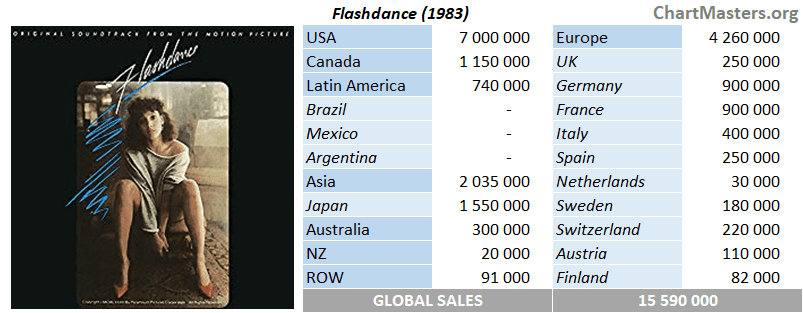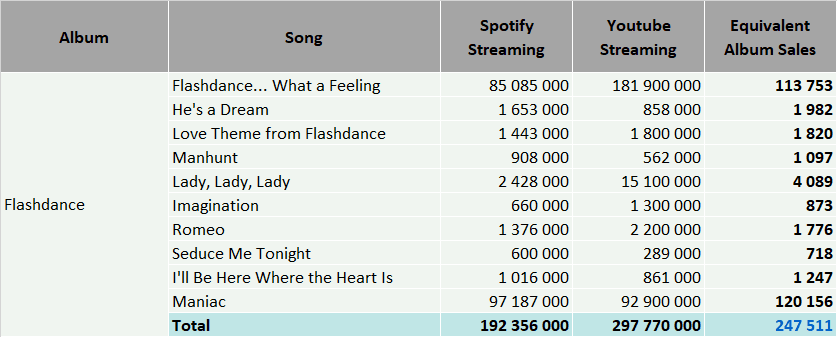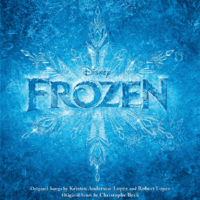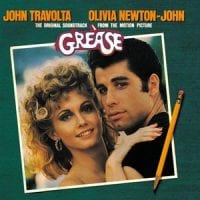Flashdance’s album and songs sales

The Greatest Showman, Mamma Mia 2, A Star Is Born, and more recently Bohemian Rhapsody, reminded to all if that was needed how big a soundtrack can be. The movie industry has always been bigger than the music industry, appealing to a wider audience. This is why exposing songs that people like through theaters can be so rewarding. It is nothing new as shown by this study of the iconic 1983 soundtrack Flashdance.
The movie wasn’t even that big at first. It opened with $5.65 million in the US while Grease had stormed on charts with over $18 million 5 years earlier without adjusting for inflation. The success of its singles was so impressive though that by its 13th week, rather than being dead already as it would have been the norm, the movie was still grossing nearly $4 million in a week. It closed its run on nearly $93 million while Lone Wolf McQuade, the movie that prevented Flashdance to enter at #1, stopped its way up at a mere $12 million.
Obviously, these numbers refer to the movie and are limited to the US. What about the soundtrack and its singles? Also, how big were they globally? How do they compete against top performers like Grease and Saturday Night Fever?
As usual, I’ll be using the Commensurate Sales to Popularity Concept in order to relevantly gauge its results. This concept will not only bring you sales information for all albums, physical and download singles, as well as audio and video streaming. In fact, it will also determine their true popularity.
If you are not yet familiar with the CSPC method, below is a nice and short video of explanations. I fully recommend watching it before getting into the sales figures. Of course, if you are a regular visitor feel free to skip the video and get into the numbers directly.
The Commensurate Sales to Popularity Concept (CSPC)
There are two ways to understand this revolutionary concept. In the first place, there is this Scribe video posted below. If you are unaware of the CSPC method, you will get the full idea within just a pair of minutes.
If you are a mathematical person, and want to know the full method as well as formulas, you can read the full introduction article.
Now let’s get into the artist’s sales figures in detail in order to apply this concept and define the act’s true popularity!
Flashdance’s Album Sales

As we are used to review the very top selling acts of all-time, album sales in 8 digits don’t even surprise us much. Except during the 90s though, selling them during a promotional campaign was extremely difficult. On its side, Flashdance cleared the 10 million level during 1983, an amazing fact back in the day.
Nowadays, it isn’t the best catalog seller out of 80s’ top sellers, but as shown by sales figures the record certainly crushed the competition from the US to Europe to Asia to South America to Oceania. In Japan, it was the first international album ever to cross 1 million units while on charts according to Oricon.
Flashdance’s songs sales

Physical Singles
As a reminder, the weighting is done with a 10 to 3 ratio between one album and one physical single.
 By 1983, physical singles were already past their peak, especially in the US. That year, only one single, Islands In the Stream by Kenny Rodgers and Dolly Parton, shipped past 2 million units. With this context, shifted over 6 million units of Flashdance… What a Feeling was a tremendous result from the young singer Irene Cara.
By 1983, physical singles were already past their peak, especially in the US. That year, only one single, Islands In the Stream by Kenny Rodgers and Dolly Parton, shipped past 2 million units. With this context, shifted over 6 million units of Flashdance… What a Feeling was a tremendous result from the young singer Irene Cara.
With only about 2 million units sold in the US and the UK combined, the song then did wonders in countries with more modest but still relevant markets. In France, it sold nearly 1,4 million, the second best selling female solo single of all-time. It is topped in this category only by L’Oiseau Et L’Enfant by Marie Myriam, the last French song which won the Eurovision contest, in 1977. The single also remains the longest running #1 of all-time at 21 weeks in Japan’s international chart among singles which also topped the comprehensive ranking.
Maniac by Michael Sembello was poised to sell less since the first single had already catapulted the general public in purchasing the LP. It still did very well, going to # in the US and to the Top 10 of most countries. Surprisingly, it peaked at a very modest #43 position in the UK.

Digital Songs
As a reminder, the weighting is done with a 10 to 1,5 ratio between one album and one digital single.

Considering how many units these songs sold through both singles and albums formats one may regard these download figures as disappointing. They aren’t forgotten though.
In this format, Flashdance… What A Feeling is easily the best performer. While Maniac challenges it in other metrics, the former is more popular in countries where downloads are higher, most notably in Asia.

Streaming
Streaming is made up of audio and video streams. Our CSPC methodology now includes both to better reflect the real popularity of each track. The main source of data for each avenue is respectively Spotify and YouTube. As detailed in the Fixing Log article, Spotify represents 157 million of the 272 million users of streaming platforms, while YouTube is pretty much the only video platform generating some revenue for the industry. Below is the equivalence set on the aforementioned article:
Audio Stream – 1500 plays equal 1 album unit
Video Stream – 11,750 views equal 1 album unit
Equivalent Albums Sales (EAS) = 272/157 * Spotify streams / 1500 + YouTube views / 11750
Streaming

While there is 8 tracks, including the former single Lady, Lady, Lady, that appear to be mostly forgotten, What a Feeling and Maniac are still largely popular. The former has the lead on YouTube at 182 million, no doubt helped by its famous video, while the latter has a slight edge on Spotify at 97 million streams. With both songs clearing the 100,000 EAS mark, the album enjoys a total of 248,000 EAS thanks to audio and video streams.
Flashdance CSPC Results

So, after checking all the figures, how many overall equivalent album sales has Flashdance achieved? Well, at this point we hardly need to add up all of the figures defined in this article!
Albums CSPC results
In the following table, all categories display figures that way, e.g. in equivalent album sales. For example, singles released in digital format sold the equivalent of 375,000 albums – 2,500,000 downloads with a 10 to 1,5 weighting.

As a reminder:
- Studio Album: sales of the original album
- Other Releases: sales of compilations generated thanks to the album
- Physical Singles: sales of physical singles from the album (ratio 3/10)
- Download Singles: sales of digital singles from the album (ratio 1,5/10)
- Streaming: equivalent album sales of all the album tracks (ratio 1/1500 for Audio stream and 1/11750 for Video stream)
One of the first successful LPs of the MTV era, Flashdance splashes out at nearly 19 million equivalent album sales. In spite of a release in a low period for the music industry, the initial reception was impressive. The album shot to #1 in most countries, famously knocking off – temporarily – Michael Jackson‘s Thriller from the top in the US.
The success of the LP is obviously mostly down to the top 2 tracks. What A Feeling and Maniac generated 9.42 million and 8.47 million EAS, respectively, enough to make both of them one of the Top 10 hits of 1983.
Discreet subsequent careers of the likes Irene Cara, Michael Sembello, and Joe Esposito limited the catalog appeal of this soundtrack. Still, in one scene only the movie and its soundtrack deeply impacted an entire generation. Instantly, millions of teenagers started dance classes and soon female pop stars where everywhere.

You may be interested in…
… best-selling artists, albums, and singles
To improve your navigation we created several amazing cross-artists lists posted inside the CSPC: Data Collector article. Click on it to see the full listing of all CSPC results compiled so far!
… similar artists
To put figures from this article into perspective, click on the images below to reach career breakdowns of similar artists:
As usual, feel free to comment and / or ask a question!
Sources: IFPI, Spotify, YouTube, Discogs.
This article is being discussed in our forum, join us to share your comments! »


